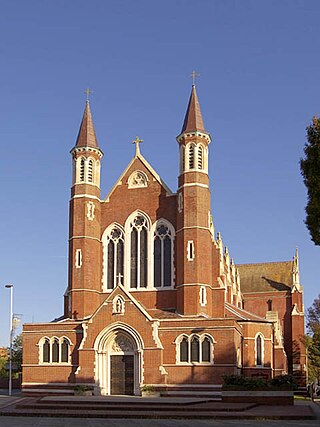
Ultramontanism is a clerical political conception within the Catholic Church that places strong emphasis on the prerogatives and powers of the Pope. It contrasts with Gallicanism, the belief that popular civil authority—often represented by the monarch's or state's authority—over the Church is comparable to that of the Pope.

Charles Butler KC was an English Roman Catholic lawyer and miscellaneous writer.

The Diocese of Clifton is a Latin Church diocese of the Catholic Church centred at the Cathedral Church of Saints Peter and Paul in Clifton, England.

Charles Walmesley, OSB was an English Catholic prelate who served as Vicar Apostolic of the Western District. He was known, especially in Ireland, for predicting the downfall of Protestantism in 1821–5 and the triumphant emergence of the Catholic Church. He was a member of the Benedictines.

The Archdiocese of Birmingham is one of the principal Latin Church diocese of the Catholic Church in England and Wales. The archdiocese covers an area of 3,373 square miles (8,740 km2), encompassing Staffordshire, the West Midlands, Warwickshire, Worcestershire and much of Oxfordshire as well as Caversham in Berkshire. The metropolitan see is in the City of Birmingham at the Metropolitan Cathedral Church of Saint Chad. The metropolitan province includes the suffragan dioceses of Clifton and Shrewsbury.

Cotton College was a Roman Catholic boarding school in Cotton, Staffordshire, United Kingdom. It was also known as Saint Wilfrid's College.
The Apostolic Vicariate of the Midland District was an ecclesiastical jurisdiction of the Roman Catholic Church in England and Wales. It was led by an apostolic vicar who was a titular bishop. The Apostolic Vicariate of the Midland District was created in 1688 and changed its name to the Central District in 1840. It was dissolved in 1850 and was replaced by two dioceses.
The Apostolic Vicariate of the Western District was an ecclesiastical jurisdiction of the Roman Catholic Church in England and Wales. It was led by a vicar apostolic who was a titular bishop. The Apostolic Vicariate of the Western District was created in 1688 and was dissolved in 1850 and replaced by two dioceses.

The Roman CatholicDiocese of Portsmouth is a Latin diocese of the Catholic Church that covers the Channel Islands as well as parts of England. The episcopal see is St John's Cathedral in Portsmouth and is headed by the Bishop of Portsmouth. The diocese is part of the metropolitan Province of Southwark, which covers all of the far South of England as well as the Channel Islands.

John Bede Polding, OSB was an English Benedictine monk and the first Roman Catholic Archbishop of Sydney, Australia.

The Roman Catholic Relief Act 1791 is an Act of the Parliament of Great Britain passed in 1791 relieving Roman Catholics of certain political, educational, and economic disabilities. It admitted them to the practice of law, permitted the exercise of their religion, and the existence of their schools. On the other hand, chapels, schools, officiating priests and teachers were to be registered, assemblies with locked doors, as well as steeples and bells to chapels, were forbidden; priests were not to wear vestments or celebrate liturgies in the open air; children of Protestants were not to be admitted to the schools; monastic orders and endowments of schools and colleges were prohibited.
James Robert Talbot was an English Catholic prelate who served as Vicar Apostolic of the London District from 1781 until his death. He was the last Catholic priest to be indicted in the country's public courts for saying Mass.
The Cisalpine Club was an association of Roman Catholic laymen formed in England in the 1790s to promote Cisalpinism, and played a role in the public debate surrounding the progress of Catholic Emancipation.

Robert Edward Petre, 9th Baron Petre was a British peer and prominent member of the English Roman Catholic nobility. He hailed from an extraordinarily affluent family and devoted himself to philanthropic endeavors. Lord Petre played a crucial role in commissioning James Paine to design a new Thorndon Hall as well as a house in Mayfair.
John Milner was an English Roman Catholic bishop and controversialist who served as the Vicar Apostolic of the Midland District from 1803 to 1826.
John Joseph Hornyold was an English Catholic bishop, titular Bishop of Phiomelia, and Vicar Apostolic of the Midland District, England for twenty-two years.
A royal veto of the appointment of bishops was proposed in the United Kingdom of Great Britain and Ireland from 1808 to 1829 during the move towards Catholic Emancipation.
The Roman Catholic relief bills were a series of measures introduced over time in the late 18th and early 19th centuries before the Parliaments of Great Britain and the United Kingdom to remove the restrictions and prohibitions imposed on British and Irish Catholics during the English Reformation. These restrictions had been introduced to enforce the separation of the English church from the Catholic Church which began in 1529 under Henry VIII.
Charles Berington was an English Roman Catholic bishop who served as the Vicar Apostolic of the Midland District from 1795 to 1798.
John Douglass was an English Catholic prelate who served as Vicar Apostolic of the London District from 1790 until his death in 1812.









